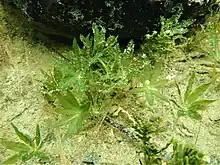| Tape-grasses | |
|---|---|
 | |
| Halophila engelmannii – Star Grass. Picture taken in Florida's Gulf Coast. | |
| Scientific classification | |
| Kingdom: | Plantae |
| Clade: | Tracheophytes |
| Clade: | Angiosperms |
| Clade: | Monocots |
| Order: | Alismatales |
| Family: | Hydrocharitaceae |
| Subfamily: | Hydrilloideae |
| Genus: | Halophila Thouars |
| Synonyms[1] | |
| |
Halophila is a genus of seagrasses in the family Hydrocharitaceae, the tape-grasses. It was described as a genus in 1806.[2] The number of its contained species, and its own placement in the order Alismatales, has evolved.
Description
These oceanic herbs grow underwater and have creeping stoloniferous stems and leafy nodes.[3] Unlike other seagrasses, the leaves of some species of Halophila do not have basal sheaths (i.e. the bases of the leaves do not wrap around the stem to form a sheath).[4]
The flowers are unisexual. The male flowers are borne on stems. The parts occur in multiples of three along a single row.[3]
The female flowers do not have stalks. They are divided into three segments. The single chambered ovary has a long beak. The three style are long and simple. The ovules are attached on top of three placentas.[3]
The fruit is included in the bract surrounding the inflorescence (the spathe) and crowned by a beak. They have many seeds and thick embryos.[3]
Distribution
This genus is widespread in tropical waters, the distribution range also extends to subtropical and temperate waters primarily the Indian and Pacific Oceans but also the Mediterranean and Caribbean Seas and the Gulf of Mexico.[1] It is found growing off the coasts of Africa, India, Australia and the Pacific Islands.[3]
Naming
The Latin specific epithet halophila refers to salt loving.[5]
Species
Species accepted by the Kew Botanical Garden.[1]
- Halophila australis - southern Australia
- Halophila baillonii - Caribbean, North and South America
- Halophila beccarii - South + East + Southeast Asia
- Halophila capricorni - New Caledonia, islands in Coral Sea
- Halophila decipiens - shores of Indian Ocean and Pacific Ocean; Caribbean, Gulf of Mexico
- Halophila engelmannii - Mexico, Costa Rica, Bahamas, Cayman Islands, Cuba, United States (PR, FL, LA, TX)
- Halophila gaudichaudii - Indian Ocean, western Pacific
- Halophila hawaiiana - Hawaii
- Halophila major - Japan, Taiwan, Southeast Asia, Caroline Is, Sri Lanka
- Halophila mikii - Japan
- Halophila minor - Indian Ocean, western Pacific
- Halophila nipponica (syn. Halophila japonica)- Korea, Japan
- Halophila okinawensis - Nansei-shoto
- Halophila ovalis - Red Sea, Indian Ocean, western Pacific
- Halophila spinulosa - Southeast Asia, North Australia, New Guinea
- Halophila stipulacea - Red Sea, Indian Ocean, invasive in the Caribbean
- Halophila sulawesii - Sulawesi
- Halophila tricostata - Queensland
Removal of Halophila johnsonii (Johnson's seagrass) from U.S. Federal List of Threatened and Endangered Species
In 2022 the National Marine Fisheries Service (NMFS) and National Oceanic and Atmospheric Administration (NOAA) ruled to remove Halophila johnsonii (Johnson's seagrass) from the Federal Endangered Species Act (ESA).[6] This ruling was based on recent genetic data obtained that show that Johnson's seagrass is not a genetically unique taxon. Johnson's seagrass is genetically similar to the Indo-Pacific species, H. ovalis, based on findings from multiple publishing's. As Johnson's seagrass is not genetically diverse, it no longer meets the requirements set by the ESA to be considered a species. The ESA defines a species as "any subspecies of fish or wildlife or plants, and any distinct population segment of any species of vertebrate fish or wildlife which interbreeds when mature 16 U.S.C. 1532". All gene samples of Johnson's seagrass from Indian River Lagoon over a 17 year study were genetically uniform. In the same study it was determined that due to the lack of genetic diversity, Johnson's seagrass was a clone of H. ovalis, closely related to populations in Africa and Antigua. The clone may be derived from a recent introduction from one of those regions (Waycott et al., 2021).[7]
References
- 1 2 3 "World Checklist of Selected Plant Families: Royal Botanic Gardens, Kew". apps.kew.org. Retrieved 2017-01-31.
- ↑ Louis-Marie Aubert du Petit-Thouars 1806. Genera Nova Madagascariensia 2
- 1 2 3 4 5 Phillips, Edwin Percy (1951). The genera of South African flowering plants. South Africa: Government Printer.
- ↑ Halophila engelmannii star grass Archived 2015-09-12 at the Wayback Machine Florida Fish and Wildlife Conservation Commission. Retrieved 2012-01-28.
- ↑ Stearn, William (1972). A Gardenerer's Dictionary of Plant Names. London: Cassell. ISBN 0304937215.
- ↑ https://www.federalregister.gov/documents/2022/04/14/2022-08029/endangered-and-threatened-wildlife-and-plants-removal-of-johnsons-seagrass-from-the-federal-list-of
- ↑ https://www.frontiersin.org/articles/10.3389/fmars.2021.740958/full
External links
- "Plants Profile for Halophila (seagrass)". www.plants.usda.gov. Retrieved 2018-08-06.
- Western Australia Seagrass web page for Halophila
- "Halophila". FloraBase. Western Australian Government Department of Biodiversity, Conservation and Attractions.